A quiet road at Bowden Hill, Wiltshire, November 1939
Category
Photographs
Date
1939
Materials
Photographic film
Measurements
105 x 147 mm
Collection
Fox Talbot Museum, Wiltshire
NT 1522791
Summary
A Dufaycolor positive film transparency, in landscape format depicting a quiet country road lined with mature trees at Bowden Hill in Wiltshire, November 1939. The transparency is set in the original Dufaycolor embossed black card mount, with a typed white label at the top: "Bowden Hill" and the subject and the date also handwritten in pencil at the bottom. One of a collection of 47 images of Lacock and the surrounding area. Dufaycolor was an early British additive colour photographic film process, introduced for motion picture use in 1932 and for still photography on roll film in 1935. It allowed the photographic reproduction of natural colour by means of a black-and-white photograph taken and viewed through a mosaic of tiny colour filters. Dufaycolor used a layer of particularly fine colour filter elements arrayed in a regular geometric mosaic, known as a réseau, consisting of alternating green and blue squares between red lines, and having roughly one million colour filter elements per square inch. The main shortcoming of this process was that the réseau absorbs most of the viewing or projection light, requiring the use of an unusually bright light for normal image brightness. The film was processed to produce the final positive image on the original film (instead of a negative). This could then be mounted to form a slide transparency for viewing. The manufacture of Dufaycolor film ended in the late 1950s.
